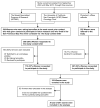Clinical and biomarker predictors of side effects from tamoxifen
- PMID: 22207277
- PMCID: PMC3335925
- DOI: 10.1007/s10549-011-1893-4
Clinical and biomarker predictors of side effects from tamoxifen
Abstract
Tamoxifen decreases breast cancer recurrence, mortality, and breast cancer risk in high-risk women. Despite these proven benefits, tamoxifen use is often limited due to side effects. We identified predictors of tamoxifen-induced side effects based on clinical variables and serum tamoxifen metabolite biomarkers in a cross-sectional study of patients taking tamoxifen. We enrolled 241 women and collected data on demographics, tamoxifen use and side effects, as well as potential clinical and serum predictors. We used logistic regression models and adjusted for age, body mass index, ethnicity, education, prior post-menopausal hormone therapy (HT), tamoxifen duration, and endoxifen levels to identify factors associated with side effects. Common tamoxifen attributed side effects were hot flashes (64%), vaginal dryness (35%), sleep problems (36%), weight gain (6%), and depression, irritability or mood swings (6%). In multi-variate models, tamoxifen duration, age, prior post-menopausal HT, and endoxifen levels all predicted side effects. Women who had been on tamoxifen for >12 months were less likely to report side effects (OR 0.15, 95% CI 0.04-0.58) or severe side effects (OR 0.05, 95% CI 0.005-0.58) compared to women on tamoxifen for <12 months. Compared to women younger than 50, women who were age 60-70 and older than 70 were less likely to report side effects (OR 0.22, 95% CI 0.03-1.35; OR 0.13, 95% CI 0.01-0.99; respectively). Women who previously took post-menopausal HT were more likely to report severe side effects. Women with higher endoxifen levels were more likely to report side effects (OR 1.67, 95% CI 1.01-2.77 per standard deviation increase in endoxifen). Clinicians should consider closely monitoring adherence in women taking tamoxifen, especially in younger women, and women who previously took HT. The association between endoxifen levels and side effects is consistent with the data that suggest that endoxifen is the most highly active metabolite of tamoxifen.
Conflict of interest statement
The authors declare that they have no conflict of interest.
Figures
References
-
- Jordan VC. Tamoxifen: a most unlikely pioneering medicine. Nat Rev Drug Discov. 2003;2 (3):205–213. - PubMed
-
- Group EBCTC. Effects of chemotherapy and hormonal therapy for early breast cancer on recurrence and 15-year survival: an overview of the randomised trials. Lancet. 2005;365 (9472):1687–1717. - PubMed
-
- Freedman AN, Graubard BI, Rao SR, McCaskill-Stevens W, Ballard-Barbash R, Gail MH. Estimates of the number of US women who could benefit from tamoxifen for breast cancer chemoprevention. J Natl Cancer Inst. 2003;95 (7):526–532. - PubMed
-
- Kloos I, Delaloge S, Pautier P, Di Palma M, Goupil A, Duvillard P, Cailleux PE, Lhomme C. Tamoxifen-related uterine carcinosarcomas occur under/after prolonged treatment: report of five cases and review of the literature. Int J Gynecol Cancer. 2002;12 (5):496–500. - PubMed
-
- Cuzick J, Powles T, Veronesi U, Forbes J, Edwards R, Ashley S, Boyle P. Overview of the main outcomes in breast-cancer prevention trials. Lancet. 2003;361 (9354):296–300. - PubMed
Publication types
MeSH terms
Substances
Grants and funding
LinkOut - more resources
Full Text Sources
Medical


